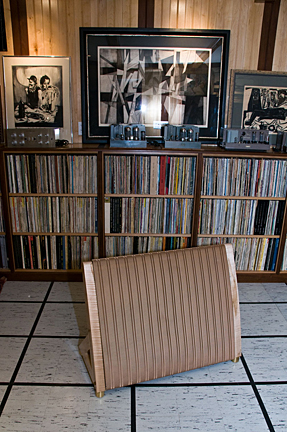
 Newfound Punch, Transparency and Detail for Your Speakers
Newfound Punch, Transparency and Detail for Your Speakers
• Remove your speaker’s cloth or foam grill. If you have a plastic phase ring (i.e. a small doughnut-shaped shield mounted with 3 or 4 thin "legs") in front of the tweeter dome, snip it off and you’ll get as much as a 100% improvement in treble clarity, dynamics and extension. We understand this requires courage because it is irreversible; hundreds of our customers have performed this Mapleshade "circumcision" with complete success.
• Almost everyone mounts small speakers on stands that are way too high (24" and up)—and usually too resonant and flimsy. Our tests clearly show that the higher you mount a small speaker, the thinner it sounds. Want to hear how much bass and warmth your speakers are losing? Try ’em on the floor, tilted back far enough to point at your ear using a wood or metal block under the front. If your floor is carpeted, lay down a heavy plank or cutting board first. Click here for even better sounding solutions--a deeper understanding of the problems caused by stands that are too high.
• If your speakers or stands are spiked to concrete, stone, tile or modern plywood floors, your system is degraded way below its potential. Click here to come to grips with the causes of the problem and the straightforward cure.
• Improving the internal wiring of speakers makes as much difference as improving your amp-to-speaker cables. Replace all internal factory wiring with 18 gauge solid core copper, preferably un-insulated wherever possible. For the ultimate in internal speaker wire quality, call (410) 867-7543.
• For speakers with one enclosure on top of another, replace the manufacturer's soft between-cabinet couplers with hard wood buttons or, for twice the effect, brass footers (e.g. Low Heavyfeet). A huge improvement for WATT/Puppies or Von Schweikerts.
• Replace your steel speaker driver mounting screws with brass ones for cleaner vibration tranfer. The tension of the screws has a surprisingly significant effect on the sound of all speakers. Do NOT tighten hard; this overdamps the sound of the speaker.
• Almost all speakers with a flat top benefit from placing small weights on that top; expect a significant improvement in clarity Start with brass or iron weights of approximately 1 pound, one in each front corner (do not use sand, lead, shot, marble, granite or slate). Experiment with moving the weights and adding more; when you get to the optimum weight, adding just another half pound can kill almost all the gains you’ve made. For the very best sounding weights you can use, Micropoint Heavyhats.
